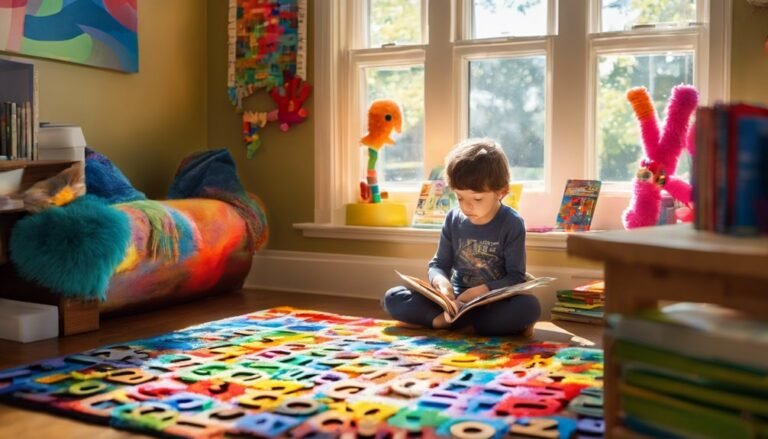Building Strong Bonds With Your Infant
Imagine your infant as a delicate seedling, blooming and growing under the gentle care and nourishment you provide. Building a strong bond with your little one is like tending to a precious garden, requiring patience, love, and attention.
But how exactly do you cultivate this connection? In this discussion, we will explore various techniques and practices that will help you foster a deep and meaningful bond with your infant, ensuring their emotional well-being and laying the foundation for a lifetime of love and trust.
So, let’s embark on this journey together, as we uncover the secrets to building strong bonds with your precious seedling.
Key Takeaways
- Bonding and responsive caregiving are crucial for emotional and social development, trust and attachment, cognitive and language development, exploration, and positive relationships.
- Skin-to-skin contact and babywearing enhance bonding, regulate body temperature, encourage breastfeeding, and promote physical and emotional well-being.
- Eye contact and facial expressions support emotional and social development, promote trust and attachment, develop facial recognition skills, and nurture emotional intelligence.
- Engaging in play and communication enhances the bond, provides joy and entertainment, contributes to language development, and fosters a deeper connection.
Importance of Bonding
Building a strong bond with your infant is crucial for their emotional and social development. The benefits of bonding go beyond just creating a loving and nurturing environment for your child. When you build a strong bond with your infant, you’re laying the foundation for their future relationships and overall well-being.
One of the key benefits of bonding is the development of trust and attachment. By consistently responding to your baby’s needs, you’re showing them that they can rely on you for comfort and security. This helps them develop a sense of trust in the world around them, which is essential for healthy emotional development. When babies feel securely attached to their caregivers, they’re more likely to explore their environment and form positive relationships with others as they grow older.
Building a strong bond with your infant also helps in their cognitive and language development. Through responsive interactions, such as talking, singing, and playing, you’re stimulating their brain and fostering their communication skills. Research has shown that babies who’ve secure attachments to their caregivers tend to have better language development and cognitive abilities later in life.
Responsive Caregiving
To foster a strong bond with your infant, it’s crucial to practice responsive caregiving, which involves attentively meeting their needs and providing a nurturing environment. Attachment parenting is a style of caregiving that emphasizes the importance of forming a secure attachment with your child. By being responsive to your infant’s cues and signals, you’re creating a foundation of trust and security that will benefit them throughout their life.
Here are three key elements of responsive caregiving that can help you build a secure attachment with your infant:
-
Sensitivity: Pay close attention to your baby’s cues and respond promptly and appropriately. This can include meeting their physical needs like feeding and changing diapers, as well as providing emotional support through cuddling, soothing, and talking to them. By consistently responding to their needs, you’re showing your baby that they can rely on you for comfort and care.
-
Consistency: Establishing consistent routines and patterns can provide a sense of security for your infant. Predictable routines for feeding, sleeping, and playtime create stability and help your baby feel safe and secure in their environment. Consistency also means being consistent in your responses to their needs, so they learn to trust that you’ll always be there for them.
-
Empathy: Try to understand and empathize with your baby’s emotions. Infants may not be able to communicate their feelings verbally, but they can still experience a range of emotions such as joy, sadness, or frustration. By acknowledging and validating their emotions, you’re showing them that you’re attuned to their inner world and that their feelings matter.
Skin-to-Skin Contact
Engage in skin-to-skin contact with your infant to foster a deep connection and promote their physical and emotional well-being. This intimate practice, also known as Kangaroo care, has numerous benefits for both you and your baby.
Bonding Benefits of Skin-to-Skin Contact:
| Bonding Benefits | Explanation |
|---|---|
| Enhanced Bonding | Skin-to-skin contact releases oxytocin, the "love hormone," which strengthens the emotional bond between you and your infant. It helps you feel more connected and attuned to your baby’s needs. |
| Regulation of Body Temperature | The warmth of your skin regulates your baby’s body temperature, keeping them cozy and comfortable. This is particularly important for premature babies who have difficulty regulating their body temperature on their own. |
| Improved Breastfeeding | Skin-to-skin contact encourages breastfeeding by stimulating the release of prolactin, the hormone responsible for milk production. It also helps your baby latch on more easily and strengthens the breastfeeding relationship. |
Babywearing and Physical Proximity
Babywearing and staying physically close to your infant can have a profound impact on their development and your bond with them. When you wear your baby, you provide them with a secure and nurturing environment that promotes their overall well-being.
Here are three ways babywearing benefits your infant’s development:
-
Enhanced Cognitive Development: Physical proximity through babywearing allows your baby to experience the world from a safe and optimal vantage point. Being close to you stimulates their senses and provides constant opportunities for learning. They can observe your facial expressions, hear your soothing voice, and learn from your daily activities, which all contribute to their cognitive development.
-
Emotional and Social Development: Babywearing fosters a strong emotional bond between you and your little one. The physical closeness promotes feelings of security, trust, and comfort, which are essential for their emotional development. It also allows them to observe and interact with the world around them, promoting social interaction and building their confidence in social situations.
-
Physical Development: The act of babywearing provides your infant with the necessary stimulation for their physical development. The gentle movements and constant contact with your body help improve their muscle tone, coordination, and balance. Additionally, being carried in an upright position aids in the healthy development of their spine and hips.
Eye Contact and Facial Expressions
When you hold your infant close and make eye contact, you create a powerful connection that strengthens your bond and supports their emotional and social development. Eye contact is a fundamental way for your baby to engage with the world around them and communicate their needs and feelings. It also plays a crucial role in the development of facial recognition skills, as babies learn to recognize familiar faces through repeated eye contact and observation.
Research has shown that eye contact and facial expressions have a profound impact on the emotional connection between you and your infant. When you lock eyes with your baby, it triggers the release of oxytocin, often referred to as the ‘love hormone.’ This hormone promotes feelings of trust, love, and attachment, creating a strong foundation for your relationship.
Facial expressions are another essential aspect of this connection. Your baby looks to your face for emotional cues and learns to interpret your expressions. By maintaining warm and responsive facial expressions, you can convey feelings of safety, comfort, and happiness to your little one. Through this mutual exchange of emotions, you’re nurturing their emotional intelligence and building a secure attachment.
Engaging in Play and Communication
To nurture a strong bond with your infant, it’s important to actively participate in play and communication. Playful interactions not only provide joy and entertainment, but they also contribute to your child’s overall development. Engaging in these activities fosters a deeper connection and helps in their language development.
Here are three ways you can enhance your bond through playful interactions:
-
Singing and talking: Your infant loves to hear your voice, so sing songs and have conversations with them. Narrate your daily activities or sing nursery rhymes. This not only captivates their attention but also helps them develop language skills.
-
Engage in peek-a-boo and tickling games: These simple games aren’t only fun but also help your child learn about object permanence and cause-and-effect relationships. They also provide opportunities for laughter and bonding.
-
Use toys and objects: Play with toys that encourage exploration and problem-solving, such as stacking blocks or shape sorters. Allow your child to manipulate objects and observe their reactions. This promotes cognitive development and strengthens the parent-infant relationship.
Establishing Daily Routines and Rituals
Establishing daily routines and rituals is crucial for building a sense of security and predictability for both you and your infant. By creating a structured environment, you provide your little one with a sense of stability, which in turn promotes their emotional well-being and development. Bedtime routines, in particular, play a significant role in helping your baby relax and prepare for sleep. Consistency is key here – try to establish a set sequence of activities, such as a warm bath, followed by a bedtime story and cuddle time. This signals to your infant that it’s time to wind down and get ready for sleep.
Mealtime rituals also hold great importance. Sitting down together for meals not only fosters a healthy relationship with food but also provides an opportunity for you to connect with your baby on a deeper level. Create a calm and inviting atmosphere during mealtimes, and try to make it a family affair whenever possible. Sharing meals together promotes bonding and creates a positive association with food and social interaction.
To help you visualize the impact of establishing daily routines and rituals, check out the table below:
| Benefits of Establishing Daily Routines and Rituals for Your Infant |
|---|
| 1. Sense of security and predictability |
| 2. Emotional well-being |
| 3. Development of healthy habits |
| 4. Increased bonding and connection |
| 5. Positive associations with daily activities |
Creating a Safe and Nurturing Environment
Now let’s explore the importance of creating a nurturing environment that promotes safety and supports your infant’s growth and development.
Building a safe and nurturing environment is essential for your infant’s well-being and overall development. Here are three key elements to consider:
-
Establish a supportive community: Surrounding yourself and your infant with a supportive community can greatly enhance your parenting journey. Seek out friends, family, or support groups who can offer guidance, encouragement, and assistance when needed. Connecting with others who are going through similar experiences can provide a sense of belonging and reassurance, creating a safe space for both you and your infant.
-
Provide sensory stimulation: Infants thrive on sensory experiences. Incorporate stimulating activities that engage their senses, such as soft toys with different textures, soothing music, or colorful mobiles. These experiences can help develop their cognitive, emotional, and physical abilities. Remember to create a calm and soothing environment as well, ensuring that your infant feels safe and secure.
-
Ensure a safe physical environment: Your infant’s safety is paramount. Create a safe space by childproofing your home, securing furniture, and using safety gates. Regularly inspect toys and equipment for any potential hazards. Always supervise your infant during playtime and ensure that sleeping areas are free from suffocation risks. By providing a safe physical environment, you can give your infant the freedom to explore and develop without unnecessary risks.
Frequently Asked Questions
How Can I Effectively Deal With Separation Anxiety in My Infant?
When dealing with separation anxiety in your infant, it is important to create a nurturing environment. Comfort them with warm hugs and reassurance, gradually introducing short separations to build trust and confidence.
What Are Some Activities or Games I Can Play With My Infant to Encourage Bonding?
You can foster a strong bond with your infant through activities like infant massage and sensory play. These interactive games not only promote bonding but also stimulate their senses, helping to build a deeper connection between you and your baby.
How Can I Create a Nurturing Environment for My Infant While Also Maintaining a Clean and Organized Home?
To create a nurturing environment for your infant while maintaining a clean home, try creating a calm atmosphere by using soft lighting and soothing music. Manage your time effectively by prioritizing tasks and asking for help when needed.
Are There Any Specific Communication Techniques I Can Use to Help Understand My Infant’s Needs and Emotions?
To understand your infant’s needs and emotions, try using communication techniques like active listening and responding with empathy. By tuning in to their cues and gestures, you can build a deeper connection and foster emotional understanding.
What Are Some Common Challenges or Obstacles That May Arise While Building a Strong Bond With My Infant, and How Can I Overcome Them?
When building a strong bond with your infant, you may face challenges like sleep regression, time management, and balancing responsibilities. But don’t worry, with patience, understanding, and support, you can overcome them and create a deep connection with your little one.
Conclusion
In the journey of building strong bonds with your infant, remember that you hold the key to unlocking a world of love and connection.
Like a gentle breeze that carries the sweet scent of blossoming flowers, your nurturing touch, responsive care, and loving presence will guide your little one towards a lifetime of happiness and emotional well-being.
Embrace these moments of togetherness and watch as your bond grows stronger with every breath you share.







